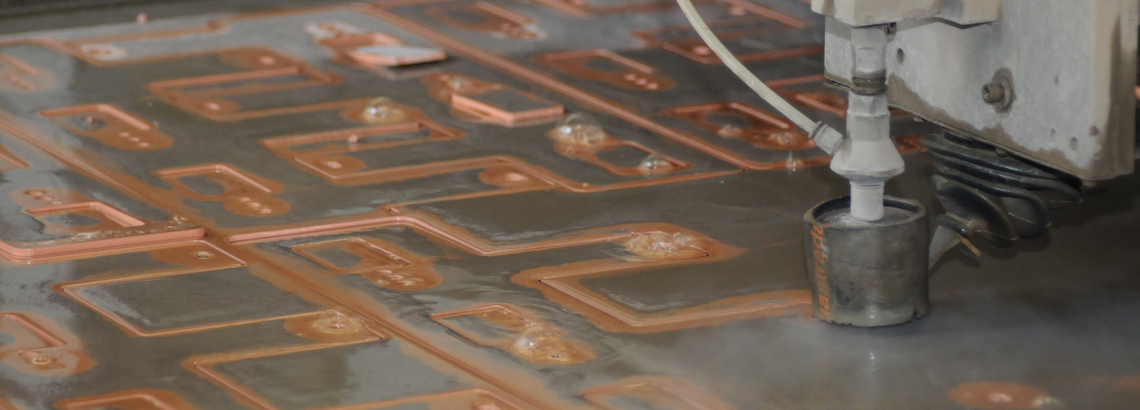

With water jet cutting, the material to be processed is separated by a high-pressure water jet. This beam has a pressure of up to 6000 bar and reaches exit speeds of up to 1000 m/s. Despite this immense power, the cut material barely heats up.
The most important advantages of the abrasive cutting:
The water jet cuts virtually any material. Typical water jet materials are aluminum, stainless steels, nonferrous metals, titanium, high-alloy steels, thermoplastics and duroplastics, composite materials, natural stone, ceramic, glass, honeycomb and hollow materials, as well as many other special materials.
Depending on the material hardness, quality cuts and rough machining are possible up to a thickness of 300 mm.
There is no development of heat. In this cold cutting process, neither structural changes, increased hardness in the peripheral region nor micro cracks in the cutting area are produced. High cutting quality: Depending on the requirements, the surface roughness can be adjusted with the feed.
Cutting qualities of N8 - N12 are common. Depending on the hardness and thickness of the material, the cutting angle error is 0-2°. The latter will be reduced by reducing the speed. The fine jet of 0.8 mm diameter allows simple to highly complex geometries to be cut. In most cases, tolerances of the mean free dimension tolerance zone can be maintained. Optically relevant parts can be cut with a protective film and thus obtain a superior cut quality.
Materials that can be cut with the water jet technology:

Punching, lasing, embossing , forming, signing
In this area, we use complex CNC-controlled systems that, in terms of cost effectiveness, are hard to beat. Lasing, punching, embossing and thread moulding are possible with a single setup in a single process. On the machines used by us, a very wide range of high quality sheet metal parts can be produced in a short time.
We process all metals, but our core competence lies in the field of non-ferrous metals. In this area, we have many years of experience in laser cutting and sheet metal processing.

With our CNC machining centers, we manufacture work pieces with the following maximum travel distances:
X = 6000mm
Y = 2000mm
Z = 1000mm
Innovative clamping devices, integrated into the zero-point clamping system, reduce our setup times by a multiple.
We can machine the following materials for you:

Punching / Embossing / Deep drawing
In this field, we utilize everything from simple C-stands and eccentric presses, to complex CNC equipment. The following is hard to beat in terms of cost effectiveness: Punching, embossing and thread moulding are possible with a single setup in a single process. In other words: On our machines, a very wide range of high quality products can be produced in a short time.
Range of capabilities:
Profiles: Thickness from 0.5 to 50 mm, width from 2 up to 200 mm
Metal sheets: Thickness from 0.5 to 12.7 mm, width up to 1500 mm
Length: up to 4000 mm coil: Thickness from 0.5 to 6 mm, width from 2 up to 300 mm
We process all metals, but are clearly specialized in the field of non-ferrous metals. In doing so, our customers benefit from our long-standing experience in laser cutting and sheet metal processing.

With our CNC bending machines, we also work with the latest technology when bending. We deform on our mechanical press brakes (which generate a pressure from 30 tons to 300 tons) dimensions from 1 mm to 3500 mm.
As a basis, we use the contour data (STEP/dxf) from the punching and laser cutting process and complement them with bending parameters. So the programs for the bending are created quickly and easily, allowing the bending process to be subsequently executed efficiently and with optimized quality. From the beginning, we minimize waste and thus costs.
The bending angles are measured automatically with high precision sensors. If necessary, the machine automatically corrects the angular dimensions. With the bending robot, we also have another option to produce parts in series production in a fully automated manner. Since we are able to develop and produce bending tools internally, we can accept all challenges.

With the G3 flatbed plotter, we have completed our cutting spectrum in all respects. Now, there are virtually no materials that we cannot cut. In addition, the plotter is an inexpensive alternative to water jet cutting and punching of thin materials. We only need a dxf file, which is read into the machine and can thus immediately start the production with little effort. Materials, such as cardboard are cut with a knife.
Other materials, such as Forex, are milled.
3D machining operations are possible.
Advantages:
Cuts and mills:
Working range:

To ensure a visually and technically optimal surface, we offer a wide variety of grinding procedures:
The vibratory finishing
The vibratory finishingis a separating process for the surface treatment primarily of metal work pieces. The work pieces are put into a container together with grinding chips and usually an additive in an aqueous solution (compound) as bulk material. Through an oscillating or rotating motion of the working container, a relative movement between work piece and grinding chip is created that produces a material removal at the work piece, particularly at the edges. The surface appearance of the work pieces, roughness, material removal and deburring results can be varied arbitrarily by machines and tools used (grinding tools and compound).